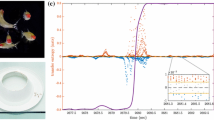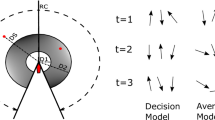Abstract
Collective behavior is broadly observed in animal groups such as insect swarm, bird flock, and fish school. Both theoretical studies and field observations have investigated possible underlying principles based on local interaction among individuals in a group without global information via conductors or leaders. Information transferred among individuals would play a key role to understand it. In this study, to investigate how individual in a swarm uses information of its own past behavior or swarm mates’ behavior, we analyzed behavior of soldier crabs Mictyris guinotae in terms of local active information storage and local transfer entropy.




Similar content being viewed by others
References
Buhl J, Sumpter DJT, Couzin ID et al (2006) From disorder to order in marching locusts. Science 312:1402–1406
Cavagna A, Cimarellib A, Giardinaa I et al (2010) Scale-free correlations in the starling flocks. Proc Natl Acad Sci 107:11865–11870
Handegard NO, Leblanc S, Boswell K et al (2012) The dynamics of coordinated group hunting and collective information-transfer among schooling preys. Curr Biol 22:1213–1217
Vicsek T, Czirok A, Ben-Jacob E et al (1995) Novel type of phase transition in a system of self-driven particles. Phys Rev Lett. 75(6):1226–1229
Couzin ID, Krause J, James R et al (2002) Collective memory and spatial sorting in animal groups. J Theor Biol 218:1–11
Niizato T, Gunji Y-P (2011) Metric-topological interaction model of collective behavior. Ecol Model 222(17):3041–3049
Radakov DV (1973) Schooling in the ecology of fish. Wiley, New York
Cavagna A et al (2014) Information transfer and behavioural inertia in starling flocks. Nat Phys. 10:691–696
Sumpter D, Buhl J, Biro D, Couzin I (2008) Information transfer in moving animal groups. Theor Biosci 127(2):177–186
Lizier JT, Prokopenko M, Zomaya AY (2012) Local measures of information storage in complex distributed computation. Inf Sci 208:39–54
Lizier JT, Prokopenko M, Zomaya AY (2008) Local information transfer as a spatiotemporal filter for complex systems. Phys Rev E 77:026110
Shannon CE (1948) A mathematical theory of communication. Bell Syst Tech J 27:379–423, 623–656
Wang XR, Miller JM, Lizier JT, Prokopenko M, Rossi LF (2012) Quantifying and tracing information cascades in swarms. PLoS One 7(7):e40084
Wang XR, Miller JM, Lizier JT et al (2011) Measuring information storage and transfer in swarms. In: Proceedings of the eleventh European conference on the synthesis and simulation of living systems, pp 838–845
Bradshaw C, Scoffin TP (1999) Factors limiting distribution and activity patterns of the soldier crab Dotilla myctiroides in Phuket, South Thailand. Mar Biol 135:83–87
Shih JT (1995) Population-densities and annual activities of Mictyris brevidactylus (Stimpson, 1858) in the Tanshui mangrove swamp of northern Taiwan. Zool Stud 34:96–105
Davie PJF, Shih HT, Chan BKK (2010) A new species of Mictyris (Decapoda, Brachyura, Mictyridae) from the Ryukyu Island, Japan. Crustac Monogr 11:83–105
Takeda S, Murai M (2004) Microhabitat use by the soldier crab Mictyris brevidactylus (Brachyura: Mictyridae): interchangeability of surface and subsurface feeding through burrow structure alteration. J Crustac Biol 24:327–339
Takeda S (2005) Sexual differences in behaviour during the breeding season in the soldier crab (Mictyris brevidactylus). J Zool Lond 266:197–204
Murakami H, Tomaru T, Niizato T et al (2015) Collective behavior of soldier crab swarm in both ring- and round-shaped arenas. Artif Life Robotics. doi:10.1007/s10015-015-0232-y (First online)
Author information
Authors and Affiliations
Corresponding author
About this article
Cite this article
Tomaru, T., Murakami, H., Niizato, T. et al. Information transfer in a swarm of soldier crabs. Artif Life Robotics 21, 177–180 (2016). https://doi.org/10.1007/s10015-016-0272-y
Received:
Accepted:
Published:
Issue Date:
DOI: https://doi.org/10.1007/s10015-016-0272-y




